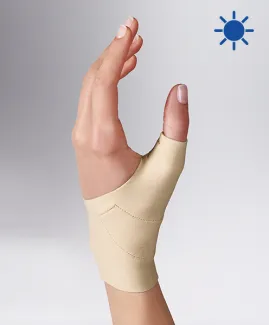
Arthritis in the thumb affects the basal thumb joint called trapeziometacarpal joint. It mainly concerns women aged 50 and over and first appears in the dominant hand. However, it often affects both hands. Some factors seem to help the onset of arthritic thumbs like genetics, menopause or the repetition of specific movements.
This condition is worsening over time, so protecting and fighting arthritis pain are important to slow down its progression. Discover how to fight arthritis in the thumb with 7 practical pieces of advice!
Advice No. 1: how to protect against arthritis in the thumb by avoiding repetitive movements?
Repetitive movements with your hands and carrying heavy objects at arm’s length or with the arm straight out are risk factors for arthritic thumb. Doing this kind of movement increases friction in the joint and so wear and tear of the cartilage. In this way, it is recommended to limit or avoid the activities that involve overuse of the joint.
This is particularly the case for leisure activities like knitting, sewing, racket sports, etc. Unfortunately, you can’t avoid them all, especially when they are part of your occupation. If you work on a computer, as a masseur or physiotherapist, your daily repetitive movements are factors that can aggravate or trigger arthritis in the thumb.
Advice No. 2 to fight arthritis pain: think about ergonomics when you use a computer
Working on a computer often causes improper movements and gestures which can favour the onset and worsening of the condition. To fight arthritis in the thumb and relieve it, avoid using the mouse, keep your elbows bent at right angles and your wrists in line with your forearm when typing. Some ergonomic tools can help you improve your comfort and limit painful movements that continue to worsen the condition.
Advice No. 3: relieve your arthritic thumb by avoiding to twist with your thumb
Twisting the thumb, hand and wrist can also cause stress and pain at the base of the thumb. By avoiding it, you would protect against arthritis in your thumbs. Here again, you can use ergonomic tools that facilitate this kind of movements and avoid thumb torsion, when opening a bottle for example.
Advice No. 4: how to fight arthritis in the thumb by keeping your hand aligned with your forearm?
Fighting arthritis pain also requires that you keep your hand aligned with your forearm as much as possible. To do that, you can wear a flexible thumb support brace. It does not impede your movements and protects your joint from micromovements by helping you, intuitively, to keep your thumb in a proper position. EPITACT® suggests you the thumb support for day use*, especially created to fight thumb arthritis pain.
Advice No. 5: try not to carry too much weight
If you avoid carrying heavy objects, you will protect against arthritis in the thumbs in the meantime. When you carry something, use both of your hands and do not hesitate to ask for help or to kit yourself out with ergonomic instruments.
Advice No. 6: avoid grabbing objects with your fingertips help to fight arthritis in the thumb
When you take an object, do not grab it just with the tip of your fingers but try to have maximum contact, using also the palm of your hand. In this way, grip strength decreases, as for the needed strength, and so you contribute to fighting arthritis more efficiently.
Advice No. 7: fighting arthritis pain with thumb support braces and splints
Wearing thumb support braces and splints regularly allows to relieve pain and keep the joints flexible. Among the EPITACT® solutions, you’ll find a solution for any moment of the day. Indeed, there is a flexible thumb support for activities* that limits harmful movements without impeding mobility.
As a complement to this day thumb support, wear the night thumb splint*. It includes semi-rigid reinforcement that immobilises your thumb in a resting position. It offers you optimal comfort as it is very thin and you can still move your fingers and flex your thumb.
Because it can’t heal on its own and worsens over time, it is important to fight arthritis in the thumb as early as possible. Try to put those pieces of advice into practice and do not hesitate to let us know if they have improved your comfort.
For more information about the possible adjustments and modifications in your everyday life, you can consult an occupational therapist. He/She is able to advise you on how to preserve the use of your hand in situations that put your joint at risk.
You’ve learnt how to protect against arthritis in the thumb and how to reduce the risk of developing or worsening your condition. If you need, you can read other articles around this topic: what are the symptoms, causes and treatment options for arthritic thumbs.
*These solutions are class I medical devices that bear the CE marking under this regulation. Carefully read the instructions before use. Manufacturer: Millet Innovation. 03/2020
 Pharmacie
Pharmacie
